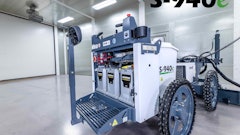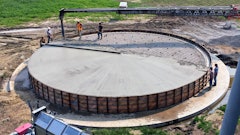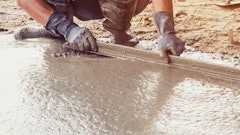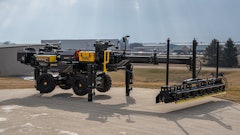
Concrete work is nothing new. Contractors have been perfecting the art of concrete pours for many years, combining new technology with their tried-and true methods. By relying on their proven, manual methods and simultaneously implementing new products and technology, contractors are able to improve finished product quality, save time and reduce labor costs.
Roller screeds (also known as tube screeds or revolving tubes) are a perfect example of this blending theory. This equipment combines the time-tested process of using something flat to smooth out concrete with the addition of a spinning tube attached to a power source. Roller screeds have been around for several years, but are gaining popularity in the rental market because of their ease of use and affordability. Here are some of the most commonly asked questions about roller screeds.
What are roller screeds?
Simply put, a roller screed consists of a power source and a single tube. The tube spins against the concrete as operators pull the unit across forms. Roller screeds are simple to operate and can be customized to fit just about any size pour, including shaped forms for curb and gutter work.
The standard tube screed can complete pours of just a few feet to those 30 feet wide. Roller screeds can run on various power sources – hydraulic, electric, gas, and the newly introduced battery option. The components are easy to set up and tear down. Perhaps most notably, they offer an upright operating position that’s much easier on the operator than a hands-and-knees alternative.
Unlike a vibrating screed, roller screeds offer an effective method for pervious paving and low slump concrete, as well as slope paving. The absence of a vibration source eliminates concrete slumping down the slope and ensures more aggregate stays near the top.
Are roller screeds hard to use?
Roller screeds are reliable, easy to maintain and don’t require much training. They’re available in a wide variety of sizes and configurations, which makes them an attractive option for contractors and DIYers alike.
Even if an operator hasn’t used a roller screed before, it’s highly likely that they can create a nearly perfect pour after running the screed. Some manufacturers offer variable speed control on their units, which makes them easier to use than a simple on/off switch. Since moisture and slump levels vary between truckloads, variable speed flexibility allows the spin speed to be adjusted on the fly to accommodate the changing material conditions.
Along with being easy to use, roller screeds reduce the skill that’s often required with concrete labor. Since the design is intuitive, contractors are able to accomplish a high-quality product with less experienced crews. Because the roller screed rides on predefined rails or forms, it gives the supervisor or foreman on a crew the ability to ensure the job is being done correctly to achieve a flatter finish.
As long as the screed is running on both of the screed rails or form points, a uniform flat surface is almost guaranteed. Other methods like vibrating or wet screeds require higher supervision because they can be difficult to operate and have a tendency to produce inconsistent results when operated by less experienced crew members.
Do roller screeds require much cleaning and maintenance?
Roller screeds are easy to clean and maintain, both for the operator and the rental center. Because of the smooth design of these tools, they require simple cleaning. Other methods, such as boards or vibrating screeds, require an on-site pressure washer to clean the equipment immediately. Because roller screeds use a spinning pipe, operators can drag the pipe over an abrasive surface like grass, dirt or sand, to easily clean the equipment. Cleaning takes less than 5 minutes.
Electric and battery-powered screeds require virtually no maintenance. There’s also minimal maintenance required with hydraulic machines, besides cleaning and occasional greasing. A gas-powered machine needs just a bit more maintenance, but still relatively little compared to other pieces of equipment. Roller screeds are reliable and don’t generally have service issues. If anything, users might have an issue with the power sources – either an extension cord for an electric model, a bad battery or a problem with the hydraulic source. These issues are usually easy to troubleshoot and don’t require an onsite visit from an expert or rental center employee.
How should roller screeds be stored?
If a rental center chooses to carry the aluminum pipes in stock, they’re easy to store and can be kept outside. As long as they aren’t bent or damaged, roller screeds have an extremely long life. In the case of damaged pipe, replacement is inexpensive and doesn’t affect the power source itself. The power component of the units should be kept inside in a temperature- and moisture-controlled environment.
Roller screeds present an additional stream of revenue for rental centers. They’re inexpensive to add to a fleet, and often turn an ROI in only a few customer rentals. After living their rental life, roller screeds also hold their value to be sold as a used unit.
What kind of customers would be interested in roller screeds?
Customers who don’t pour concrete every day will be the most interested in roller screeds. The equipment is ideal for concrete patchwork, smaller pours or one-off projects. It isn’t meant to replace larger pieces of equipment.
Roller screeds are highly versatile, offering sizes and configurations for just about any sized project from patchwork and sidewalks to larger areas like parking lots and streets.
Roller Screeds also offer a unique solution to projects that might have space or emission restrictions, such as indoors or difficult-to-access areas like basements. Battery-powered units, specifically, are a great option when contractors need to consider emissions. These units operate with no cords, hoses or fumes, making them a highly mobile and precise piece of equipment. For rental centers looking to offer the most convenient option, units that offer ample power with one convenient, removable and rechargeable battery means less hassle for renters and employees.
No matter the power source, roller screeds make a great option for people looking to complete a unique pour. Heavier, industrial-focused contractors will find the hydraulic system the best fit, while smaller, municipal contractors might find the most efficient will be a gas, electric or battery-powered roller screed. Roller screeds offer an ideal solution for larger spaces like highways, bridges and ditch embankments, as well as bike trails, golf cart paths, garage pads and shed floors. Some manufacturers offer attachments to achieve more complicated pours, including a center pivot kit to tackle circular pours like grain bin pads.
Roller screeds meet the market's demand to make concrete more achievable to workers of all skill levels. With equipment that is adjustable, convenient and easy to operate, contractors can take on more jobs and projects than they may have previously. By incorporating these user-friendly machines into their lineup, rental centers can offer new opportunities to both contractors and DIYers.
By Seth Ulmer, Curb Roller Manufacturing sales manager





























